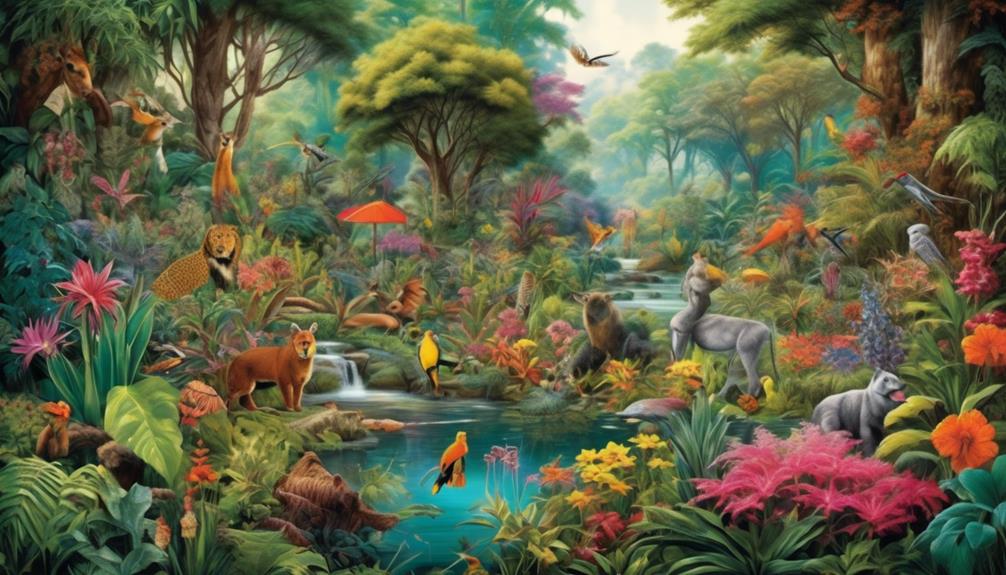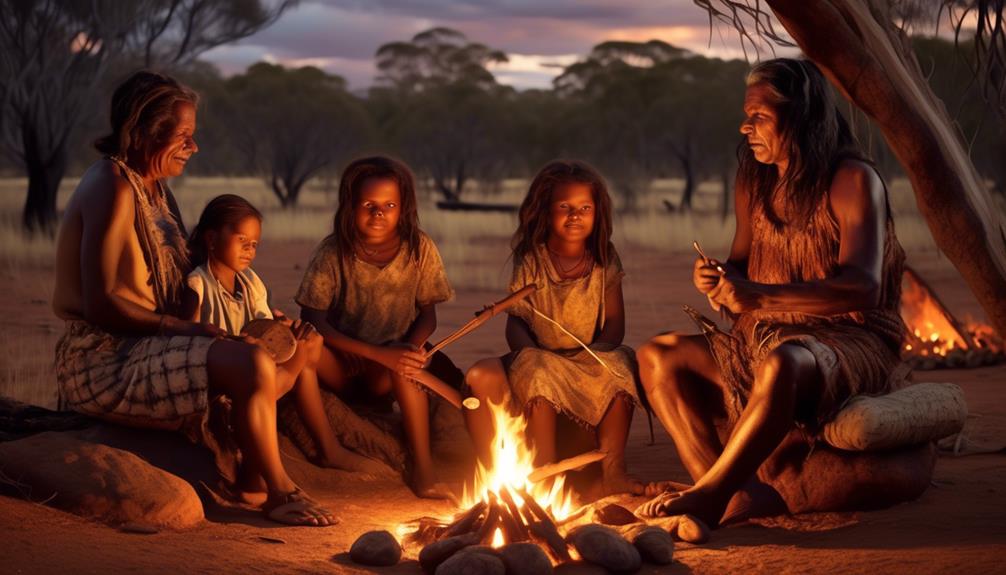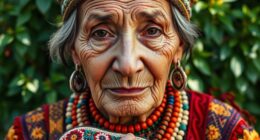You may already know about the strong impact of an artist who transcended cultural boundaries and left behind a lasting legacy. Jimmy Pike’s remarkable journey serves as a testament to the resilience of the human spirit and the power of art to bring people together despite their differences.
His unique blend of traditional Aboriginal techniques and contemporary artistic expression continues to captivate audiences around the world.
But what challenges did he face, and how did he navigate them to achieve international recognition?
His story is a compelling exploration of art, culture, and the enduring influence of an extraordinary individual.
Key Takeaways
- Jimmy Pike grew up in the remote Australian desert, immersed in the rich cultural traditions of the Kija people.
- His artwork reflects a profound sense of Indigenous inspiration, using bold colors, striking patterns, and traditional techniques such as dot painting.
- Pike's art has gained worldwide acclaim, inspiring a new appreciation for Indigenous artistic expression and facilitating meaningful dialogue across diverse communities.
- Despite facing cultural displacement and discrimination, Pike persevered and used art to promote understanding, leaving behind a legacy that continues to influence the art world and preserve Aboriginal cultural heritage.
Early Life and Cultural Roots
Growing up in the remote Australian desert, Jimmy Pike was immersed in the rich cultural traditions of the Kija people, which would profoundly shape his artistic vision. His childhood experiences were filled with the vibrant storytelling, intricate dot paintings, and connection to the land that are integral to Kija culture. From a young age, he learned the significance of Dreamtime stories, the language of the land, and the spiritual connection to ancestral beings. These cultural traditions served as the foundation for his later artistic expressions, influencing his use of bold colors, intricate patterns, and deep storytelling in his artwork.
Pike's immersion in the Kija cultural traditions during his formative years provided him with a deep understanding of the interconnectedness of all living things and the importance of preserving traditional knowledge. His childhood experiences instilled in him a profound respect for the land and its stories, which became evident in his artistic endeavors. The influence of these cultural roots on Pike's early life laid the groundwork for his future as a renowned artist, allowing him to share his unique perspective with the world.
Artistic Style and Techniques

Immersed in the rich cultural traditions of the Kija people during his formative years, Jimmy Pike developed an artistic style and techniques that vividly capture the essence of his cultural heritage. His art is characterized by a profound sense of Indigenous inspiration, reflecting the spiritual connection to the land and the ancestral stories passed down through generations.
Pike's artistic innovation is evident in his use of bold, vibrant colors and striking geometric patterns, which are emblematic of the Kija artistic tradition. His techniques, often involving the use of natural pigments and traditional methods such as dot painting, demonstrate a deep understanding of his cultural roots and a commitment to preserving and celebrating Indigenous art forms.
Pike's style is renowned for its ability to seamlessly blend traditional motifs with a contemporary artistic sensibility, creating visually stunning pieces that resonate with audiences worldwide. His unique approach to storytelling through art, depicting the landscape and the spiritual significance of ancestral sites, has garnered widespread acclaim for its authenticity and emotive power.
Through his art, Pike not only showcases the beauty of his cultural heritage but also serves as a testament to the enduring legacy of Indigenous artistic expression.
International Recognition and Impact
Gaining worldwide acclaim, Jimmy Pike's art has left a lasting impact on the global art community, inspiring a new appreciation for Indigenous artistic expression. His bold and vibrant paintings, which often depict the landscapes and stories of his Walmajarri heritage, have resonated across cultures, fostering a deeper understanding of Indigenous Australian art.
Pike's work has transcended geographical boundaries, contributing to a global impact that extends far beyond his homeland.
Pike's art has played a significant role in fostering cross-cultural exchange, as it has been showcased in numerous international exhibitions and galleries. His ability to communicate the richness of Indigenous culture through visual storytelling hasn't only captivated audiences worldwide but has also facilitated meaningful dialogue and understanding across diverse communities.
His legacy continues to inspire artists and art enthusiasts to engage with Indigenous art forms, promoting a deeper appreciation for the cultural significance and artistic excellence found within these traditions.
Through his art, Jimmy Pike hasn't only achieved international recognition but has also made a profound and enduring impact on the global art landscape, fostering greater awareness and respect for Indigenous artistic expression.
Challenges and Resilience

Despite facing numerous obstacles, Jimmy Pike's unwavering determination and resilience allowed him to overcome challenges and continue pursuing his artistic endeavors. Pike's resilience was evident as he navigated the complexities of being a Walmajarri man in a rapidly changing world, balancing the preservation of his cultural heritage with the demands of modern society. His incarceration for a crime he did not commit and the subsequent years spent in prison could have easily stifled his artistic inspiration, yet Pike found solace and creativity in painting, using his experiences to fuel his art. The following table highlights some of the key challenges Pike encountered and the resilient ways in which he tackled them:
| Challenges Faced | Resilient Response | Artistic Inspiration |
|---|---|---|
| Cultural displacement | Embracing heritage | Depicting traditional stories |
| Unjust imprisonment | Finding solace in art | Expressing emotions through paint |
| Limited resources | Resourcefulness | Creating art with available materials |
| Discrimination | Perseverance and advocacy | Using art to promote understanding |
Pike's ability to channel his resilience into his artistic pursuits not only allowed him to overcome personal challenges but also to inspire others through his powerful and evocative artwork.
Legacy and Continuing Influence
Pike's indomitable spirit and artistic resilience have left a lasting legacy that continues to influence contemporary artists and inspire new generations. His unique blend of traditional Aboriginal art techniques with modern influences has had a profound impact on the art world, extending far beyond his lifetime. His influence can be seen in various forms, from the vibrant colors and intricate patterns used by contemporary artists to the incorporation of storytelling and cultural heritage in their artwork.
Contemporary artists continue to draw inspiration from Pike's bold and innovative approach to storytelling through art, infusing their own work with a similar sense of narrative depth and cultural significance.
Pike's legacy has also spurred a renewed interest in preserving and celebrating Aboriginal cultural heritage, with many artists and organizations actively working to ensure that traditional art forms and stories are passed down to future generations.
The enduring influence of Pike's work serves as a reminder of the power of art to transcend boundaries, connect people across time and culture, and preserve the rich tapestry of human experience.
Frequently Asked Questions
What Was Jimmy Pike's Favorite Childhood Memory?
Your favorite childhood memories are often shaped by cultural influences. These memories can be tied to special moments, traditions, or experiences that hold a special place in your heart. They often provide a sense of comfort and connection to your roots.
These memories may include family gatherings, holidays, or unique customs that reflect your cultural heritage. They play a significant role in shaping your identity and sense of belonging.
Did Jimmy Pike Have Any Hidden Talents or Hobbies Outside of His Artistic Career?
You've probably wondered if someone as talented as Jimmy Pike had any hidden talents or leisure activities outside of his artistic career.
Many artists have a wide range of interests and hobbies that contribute to their creativity. It's not uncommon for creative individuals to excel in other areas like music, sports, or even cooking.
Exploring these diverse talents can provide a well-rounded and enriched perspective, enhancing their artistic abilities.
What Were Some of the Biggest Misconceptions About Jimmy Pike's Work During His Lifetime?
When it comes to misconceptions about art, it's important to recognize that they can greatly impact an artist's influence. Many artists have faced misconceptions about their work during their lifetime, which can hinder their artistic influence.
It's crucial to understand and appreciate an artist's work without falling prey to misconceptions. By debunking these misconceptions, you can gain a deeper understanding of an artist's true impact on the art world.
How Did Jimmy Pike Navigate the Intersection of His Indigenous Heritage and Modern Western Influences in His Art?
In navigating the intersection of indigenous identity and modern art, artists often explore cultural fusion and artistic expression. They blend traditional techniques with contemporary themes to depict their heritage in innovative ways.
This approach allows them to honor their roots while engaging with current artistic trends. It's a delicate balance, but when done successfully, it creates powerful, thought-provoking works that resonate with audiences across cultural boundaries.
What Connections Did Jimmy Pike Have With Other Contemporary Indigenous Artists Around the World?
In the realm of contemporary influences, many indigenous artists around the world have found themselves engaging in global collaborations. The interconnectivity and shared experiences of indigenous cultures have fostered a rich tapestry of artistic exchange and cooperation.
This has led to the creation of diverse and inspiring works that draw from both traditional and modern influences, showcasing the depth and breadth of indigenous art on a global scale.
Conclusion
You've learned so much about Jimmy Pike, from his early life and cultural roots to his international impact and enduring legacy.
As the saying goes, 'The apple doesn't fall far from the tree,' and Pike's artistic talent and resilience certainly reflect his rich cultural heritage.
His influence continues to inspire and captivate audiences around the world, leaving a lasting and powerful imprint on the art world.
Mary is a passionate writer who brings creativity and a fresh perspective to our team. Her words have the power to captivate and inspire, making her an essential contributor to our content. Mary’s commitment to storytelling and dedication to promoting Indigenous culture ensures that her work touches the hearts of our readers. We’re fortunate to have her as part of our team.










